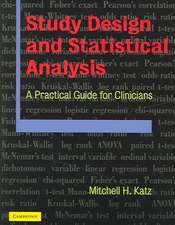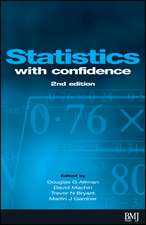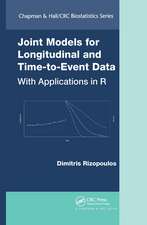Epidemiology of Electromagnetic Fields: Biological Effects of Electromagnetics
Editat de Martin Rooslien Limba Engleză Hardback – 3 iun 2014
Fueled by more than 30 years of intensive research and debate on the impact of electromagnetic fields (EMF) on everyday life—starting with residential exposure to magnetic fields and the development of childhood cancer in the 70s and continuing with risk of exposure via wireless communications in present day—Epidemiology of Electromagnetic Fields addresses ongoing public and scientific controversy surrounding the possible effects of electromagnetic fields (EMF) to human health, and provides an in-depth introduction into the methodology of environmental epidemiology that is appropriate for all levels, from student to practicing engineer.
Exposure to EMF
Focusing primarily on EMF examples, the author presents the general principles and methodological concepts in environmental epidemiology. Topics of importance in the first part of the book include epidemiological study designs, exposure assessment methods and implications for the study results, as well as selection bias, confounding, and other biases including reverse causality and ecological fallacy. The second part of the book covers environmental epidemiological methods in detail and outlines key examples such as childhood leukemia and exposure to extremely low-frequency magnetic fields, as well as examples that look at brain tumors and mobile phone use. The book also offers a detailed discussion on the range of EMF sources and exposures. In addition, it highlights the sophisticated assessment methods required to address exposure situations, and provides a historical perspective. The third part of the book examines how EMF exposure from the use of wireless communication techniques and other challenges affect risk assessment today and also details future developments.
- Explores environmental epidemiological methods in detail, while critically discussing epidemiological findings
- Provides a state-of-the-art overview of the scientific evidence of the health effects of EMF
- Considers how novelty, the steep increase of radiofrequency (RF) EMF exposure from wireless communications, and other challenges affect risk assessment today
Preț: 1237.50 lei
Preț vechi: 1302.63 lei
-5% Nou
Puncte Express: 1856
Preț estimativ în valută:
236.82€ • 257.16$ • 198.93£
236.82€ • 257.16$ • 198.93£
Carte tipărită la comandă
Livrare economică 23 aprilie-07 mai
Preluare comenzi: 021 569.72.76
Specificații
ISBN-13: 9781466568167
ISBN-10: 146656816X
Pagini: 368
Ilustrații: 40 black & white illustrations, 32 black & white tables
Dimensiuni: 178 x 254 x 25 mm
Greutate: 0.84 kg
Ediția:1
Editura: CRC Press
Colecția CRC Press
Seria Biological Effects of Electromagnetics
ISBN-10: 146656816X
Pagini: 368
Ilustrații: 40 black & white illustrations, 32 black & white tables
Dimensiuni: 178 x 254 x 25 mm
Greutate: 0.84 kg
Ediția:1
Editura: CRC Press
Colecția CRC Press
Seria Biological Effects of Electromagnetics
Public țintă
Academic and Professional Practice & DevelopmentCuprins
Introduction. Part I Epidemiological Concepts and Principles. Epidemiological Study Design: Architecture for Research. Occupational EMF Studies. Epidemiological Exposure Assessment. Selection and Detection Bias. Confounding, Reverse Causation, and Ecological Fallacy. Part II State of Scientific Knowledge. Exposures to ELF-EMF in Everyday Environments. Exposure to Radiofrequency Electromagnetic Fields in Our Everyday Environment. Childhood Leukemia and Extremely Low-Frequency Magnetic Fields: Critical Evaluation of Epidemiologic Evidence Using Hill’s Framework. Adult Cancer and Extremely Low-Frequency Magnetic Fields. Neurodegenerative Diseases and ELF-EMF. Brain Tumors and Mobile Phone Use: The Cohort Approach. Brain Tumors and Mobile Phone Use: The Case–Control Approach. Brain Tumors and Mobile Phone Use: The Ecological Approach. Synthesis of Epidemiological Studies on Mobile Phone Use and the Risk of Brain Tumors. Electromagnetic Fields, Symptoms and Idiopathic Environmental Intolerance. Part III The Broader Perspective. How Can Future Epidemiology and Laboratory Studies Complement Each Other?. What If? The Public Health Perspective. An Outlook into Future EMF Exposure Scenarios. Future of EMF Epidemiology. Index.
Notă biografică
Martin Röösli has a background in atmospheric physics and a PhD in environmental epidemiology. He is a professor at the Swiss Tropical and Public Health Institute in Basel. His research focuses on environmental health and includes exposure assessment studies, etiological research, and health risk assessment in the areas of electromagnetic fields, ionizing radiation, noise exposure, passive smoking, climate change, and ambient air pollution. He has conducted epidemiological studies on personal exposure and health effects of electromagnetic fields, is a member of various national and international commissions on environmental health risk, and has published numerous scientific papers, reviews, and book chapters.
Recenzii
"[A]ll scientists interested in environmental epidemiology, or more specifically the epidemiology of electromagnetic fields, should have this book on their shelves. A health physicist or scientist who wants to know pretty much everything about these subjects will find the chapters of this book a treasure trove of information selected by experts in the field. Even an expert in the field will take pleasure in finding that the authors have addressed esoteric topics like ‘reverse causation.’"
—Health Physics, April 2015
—Health Physics, April 2015
Descriere
This book gives an overview of the epidemiological methods used to research the effects of electromagnetic fields (EMFs) on human health. The first part of the book introduces epidemiological concepts and principles, providing appropriate examples and tips for practical usage. The second part details the state of scientific knowledge for some controversial issues in EMF research, while the third part considers how novelty, the steep increase of radiofrequency (RF) EMF exposure from wireless communications, and other challenges affect risk assessment today.
















